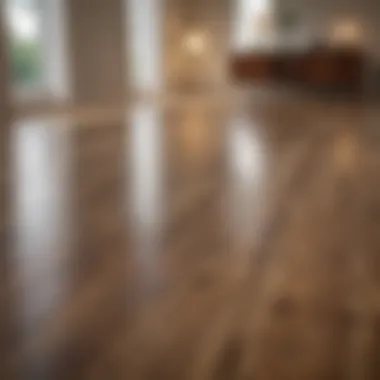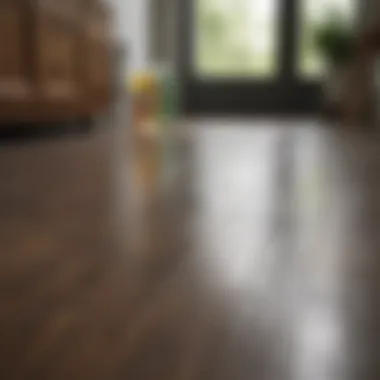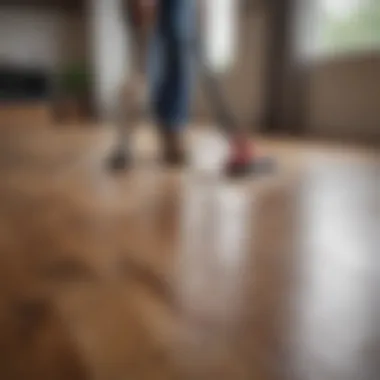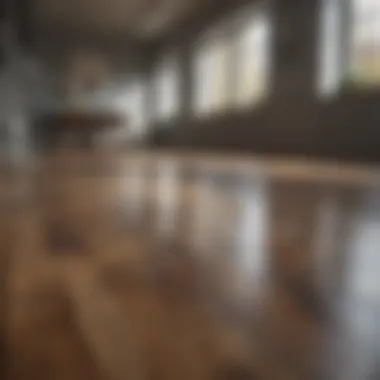Expert Techniques for Cleaning Laminate Wood Floors


Intro
Cleaning laminate wood floors requires a careful approach to preserve their beauty and longevity. Homeowners have the challenge of keeping their spaces pristine while avoiding damage to the flooring. Laminate surfaces, though durable, are sensitive to moisture and strong chemicals. Understanding the best practices for cleaning these floors can enhance their appearance and extend their lifespan. This article will explore various effective techniques and suitable products that cater to the unique needs of laminate wood floors.
Inspiring Homes
Creating a well-maintained home not only enhances its aesthetic value but also contributes to the overall comfort and ambiance. Laminate wood floors provide a stylish, cost-effective solution to homeowners looking for elegance without compromising durability. Proper cleaning methods significantly impact the flooring's visual appeal and durability, making it essential to learn about the most effective techniques.
Key Cleaning Techniques
- Dust Mopping: Regular dust mopping is essential in maintaining laminate floors. Using a microfiber mop can trap dirt and dust effectively without scratching the surface.
- Damp Mopping: When deeper cleaning is necessary, a damp mop can be utilized. It's crucial to wring out the mop thoroughly to avoid excess water, which can seep between the seams and cause damage.
- Spot Cleaning: Promptly addressing spills and stains ensures that they do not set into the laminate. Using a soft cloth with a mild cleaner specifically designed for laminate floors can help.
"Maintaining laminate wood floors is not just about cleanliness; it’s about preserving the integrity of your investment."
Recommended Cleaning Products
- Bona Laminate Floor Cleaner: This product is favored for its effectiveness and safe formula, tailored for laminated surfaces.
- Zep Hardwood and Laminate Floor Cleaner: Known for its reliable results, it works well in lifting dirt without leaving strong residues.
- Tertially Microfiber Mop: Useful for both dry and damp cleaning, ensuring the maintenance of the floor’s shine.
Common Pitfalls to Avoid
Homeowners often make mistakes that can lead to damage. Some of these include:
- Using Excess Water: This can warp and buckle the flooring.
- Harsh Chemicals: Abrasive products can strip the finish and dull the surface.
- Scrubbing: Vigorous scrubbing can scratch the laminate finish.
Through consistent application of these methods and careful consideration of materials, you can achieve lasting beauty for your laminate wood floors, preserving their look for years to come.
Understanding Laminate Wood Floors
Understanding laminate wood floors is essential for homeowners looking to maintain both the aesthetics and durability of their flooring. This knowledge influences how one cleans and cares for these surfaces. Laminate flooring has specific attributes that set it apart from other types of flooring, such as hardwood or vinyl. Recognizing these characteristics is crucial for adopting the right cleaning methods and ensuring the material's longevity.
Composition of Laminate Wood
Laminate wood flooring is primarily made from four layers. The base layer provides stability, the core layer contributes to durability and moisture resistance, while the image layer replicates the look of natural wood. Lastly, a protective overlay shields against scratches and wear. The combination of these materials offers a resilient surface that can withstand heavy foot traffic. Understanding the layers helps in selecting appropriate cleaning products that will not damage the flooring.
Benefits of Laminate Flooring
Laminate flooring offers several attractive features that appeal to homeowners. One significant benefit is its cost-effectiveness compared to solid hardwood flooring. Additionally, laminate is relatively easy to install, making it a popular choice for DIY enthusiasts. Its versatility allows for various designs and styles, mimicking the appearance of genuine wood, stone, or tile. Moreover, laminate flooring is low maintenance, requiring less frequent cleaning than other materials.
Common Misconceptions
There are several misconceptions surrounding laminate wood floors that can affect how effectively they are cleaned. One common myth is that laminate flooring cannot be wet cleaned. While excessive water can lead to damage, a damp mop can be used safely without harming the material. Also, some believe that laminate is less durable than hardwood. In reality, many laminate options are resistant to scratches and wear, outperforming some hardwoods in high-traffic environments. Addressing these misconceptions can help homeowners care for their flooring more effectively.
Essential Cleaning Tools
Cleaning laminate wood floors effectively requires the right tools. Using suitable instruments ensures that the cleaning process is efficient and safe. Each tool has its own unique purpose and contributes to maintaining the elegance and durability of the flooring.


Choosing the Right Mop
The mop is a fundamental tool in cleaning laminate wood floors. Selecting the right type is crucial. Traditional mops, especially those that are sponge-based, can leave excessive water on floors. This moisture can seep into seams, causing damage over time. Instead, consider a microfiber mop. These mops are designed to trap dirt and dust effectively. They also require less water, making them ideal for laminate surfaces.
When selecting a mop, look for one with a removable and washable pad. This not only saves money on disposable pads but also ensures you maintain hygiene. Many adjustable mops allow users to reach different angles, making it easier to clean corners and under furniture.
Selecting Cleaning Solutions
Choosing the correct cleaning solution is another critical factor in maintaining laminate flooring. Conventional floor cleaners may contain harsh chemicals that can harm the laminate's surface. Instead, consider pH-balanced solutions specifically designed for laminate. These products help lift dirt without creating a film.
Alternatively, some homeowners prefer to create homemade cleaning solutions. A simple mix of water and white vinegar has been effectively used for decades. Remember, the ratio should typically be one cup of vinegar to one gallon of water. Test the solution on a small, inconspicuous area before applying it to the entire floor.
Important: Always check the manufacturer’s guidelines for cleaning solutions suitable for your flooring.
Microfiber Cloths and Their Benefits
Microfiber cloths have become essential in maintaining laminate wood floors. They are superior to regular cleaning rags. Made of tiny fibers, they can trap and hold dust, dirt, and grime. This characteristic makes them especially effective for routine dusting or spot cleaning.
When using microfiber cloths, ensure they are slightly dampened. Excess moisture can still damage the laminate, but a slightly moist cloth will pick up more dirt without leaving streaks. Additionally, many microfiber cloths can be washed and reused, making them an eco-friendly option. Their versatility means they can be used for both cleaning and polishing, helping to retain the shine of your floors.
In summary, investing in the correct cleaning tools—like a quality mop, the right cleaning solutions, and effective microfiber cloths—will not only enhance your cleaning routine but also prolong the life and appearance of your laminate wood floors. It can make the task of maintaining these surfaces much simpler.
Daily Cleaning Routine
Maintaining the beauty and integrity of laminate wood floors requires a consistent and effective daily cleaning routine. This is essential not only for aesthetic reasons but also for prolonging the life of the flooring. Regular upkeep helps to prevent the build-up of dirt and debris, which can lead to scratches and dullness over time. An organized cleaning schedule allows homeowners to quickly address messes and ensures that floors always look their best.
Dusting Techniques
Effective dusting is at the core of a successful daily cleaning regime for laminate wood floors. Dust and debris can accumulate quickly, especially in high-traffic areas. Here are some effective techniques to consider:
- Use a Microfiber Mop: Microfiber mops are excellent for picking up fine dust and allergens. Unlike traditional brooms, they catch dirt instead of pushing it around.
- Frequency: Aim to dust the floor at least once a day. In high-traffic areas, doing so twice may be necessary.
- Clean Solution: When using a microfiber mop, consider lightly dampening it with water or a suitable cleaning solution. This enhances its effectiveness without oversaturating the floor.
The importance of regular dusting cannot be overstated. Not only does it maintain the appearance of the laminate flooring, but it also contributes to a healthier indoor environment.
Spot Cleaning Spills
Inevitably, spills will happen, and laminate floors are no exception. Understanding how to effectively address spills can prevent long-term damage:
- Act Quickly: The sooner you clean a spill, the better. Liquids can seep into seams, causing swelling or warping if left unattended.
- Use the Right Cloth: Always keep a soft cloth or paper towel handy. Avoid abrasive materials that could scratch the laminate surface.
- Mild Cleaning Solution: For sticky or tough spills, use a gentle solution. A mix of water and a few drops of dish soap can work well. Always dampen the cloth rather than soaking it.
- Wipe and Dry: After cleaning, ensure that you wipe the area dry to prevent moisture build-up.
"Timely and appropriate responses to spills are crucial to maintaining laminate wood flooring's visual appeal and structural integrity."
In summary, establishing an efficient daily cleaning routine, which includes proper dusting techniques and proactive spot cleaning, is vital. By incorporating these practices, homeowners can significantly enhance the longevity and beauty of their laminate wood floors.
Deep Cleaning Methods


Deep cleaning laminate wood floors is essential for maintaining both their aesthetic appeal and durability. Unlike regular cleaning, which targets surface dirt and dust, deep cleaning goes further to remove embedded grime and stubborn stains. This thorough approach helps to extend the life of your floors and keeps them looking fresh and vibrant.
Recommended Frequency
The frequency of deep cleaning depends on traffic and environmental factors. For most homes, a deep clean every three to six months is adequate. Houses with pets or young children may require more frequent attention due to increased wear and tear.
Regular deep cleaning not only maintains the visual appeal of the floors but also helps in preserving the laminate material. Dust and dirt can accumulate, leading to scratches, which diminishes the floor's overall look. Make a note on your calendar to remind yourself of your deep cleaning schedule to ensure it does not get overlooked.
Using Steam Cleaners
Steam cleaners can be highly effective for deep cleaning laminate floors. They utilize heat and moisture to lift dirt without the need for harsh chemicals. When using a steam cleaner, always ensure that it is suitable for laminate flooring, as excessive water can cause damage. Here are some tips for using steam cleaners:
- Set the machine to a low steam setting. High steam can warp laminate planks.
- Keep the nozzle at a distance from the floor surface to prevent water accumulation.
- Ensure thorough drying. After steaming, let the floor dry completely before walking on it.
"Steam cleaning can revitalize your laminate floors, providing a refreshing clean without the risk of chemical residues."
Homemade Cleaning Solutions
Some homeowners may prefer to create their own cleaning solutions. Homemade cleaners are often more environmentally friendly and cost-effective. Here are a few simple recipes:
- Vinegar Solution: Mix one cup of white vinegar with one gallon of warm water. This solution is excellent for removing light dirt and grime without leaving streaks.
- Dish Soap Cleaner: Combine a few drops of mild dish soap with a bucket of warm water. This option effectively tackles sticky spots without damaging the floor surface.
When using any homemade solution, test it on a small, inconspicuous area first. This precaution helps ensure that it does not discolor or harm the laminate. Homemade cleaners can be a sustainable choice for those looking to maintain laminate floors with minimal environmental impact.
Potential Pitfalls in Cleaning
Cleaning laminate wood floors can often seem straightforward, but there are significant pitfalls that can compromise the appearance and quality of these surfaces. Understanding these challenges is essential for maintaining the long-lasting aesthetic appeal and usability of your flooring. Every homeowner should be aware of common mistakes to avoid potential damage. The benefits of this understanding include prolonging the life of the laminate, preserving the original shine, and ensuring a clean environment. Exploring these pitfalls can help create a road map for effective cleaning practices.
Avoiding Excess Water
One of the critical pitfalls in cleaning laminate wood floors is the use of excess water. Laminate flooring is constructed from layers of fiberboard topped with a photographic layer that mimics wood. This structure means that water can seep through the seams if too much is applied, leading to warping, swelling, or separation of the layers. Excess water can also encourage mold growth, which poses health risks.
To avoid this, homeowners should use only a slightly damp mop when cleaning. It's important to wring out the mop thoroughly before applying it to the floor. This ensures that the surface remains effectively cleaned without risking significant exposure to water. Moreover, following up the mopping procedure with a dry microfiber cloth can help mitigate any excess moisture left behind, thus preserving the flooring's integrity.
"Excess water can lead to irreversible damage. Always ensure to mop your laminate floor with a damp, not wet, mop."
In addition, utilizing cleaning solutions that are designed to be used with minimal water will further prevent any negative effects of moisture. This gentle approach not only cleans the surface but does so in a manner that respects the laminate's material properties.
Incorrect Cleaning Products
Using incorrect cleaning products is another prevalent pitfall. Many household cleaners contain harsh chemicals that can dull the finish or discolor laminate flooring. This misstep not only affects the visual appeal but may also lead to costly repairs or replacement in the long run. Products that are oil-based or have a wax formulation should be strictly avoided, as they can leave residues that attract dirt and compromise the floor’s sleek appearance.
Instead, it is advisable to choose pH-neutral cleaning solutions specifically formulated for laminate floors. These products clean effectively without the aggressive effect of harsher substances. Always check labels for compatibility with laminate materials.
Homeowners should also refrain from using abrasive tools such as steel wool or scouring pads, which can scratch or damage the surface. Opting for softer alternatives, such as microfiber cloths or soft mops, safeguards the finish while ensuring a thorough clean. Taking time to understand what products are best suited for laminate flooring can save homeowners significant time and expense in maintaining their investment.


Long-Term Maintenance Tips
Maintaining laminate wood floors goes beyond occasional cleaning. Long-term maintenance plays a crucial role in preserving their aesthetic appeal and functionality. A well-maintained floor can last for many years, keeping not just your home looking good but also retaining its value. This section discusses various strategies that homeowners can implement to extend the life of their laminate flooring.
Preventive Measures
Preventive measures are the first line of defense against damage to laminate floors. Simple practices can significantly reduce wear and tear.
- Use Felt Pads: Installing felt pads under furniture legs can prevent scratches and dents. This small change protects the floor from heavy items being moved over it.
- Maintain Proper Humidity: Laminate flooring can expand and contract with fluctuations in humidity. Keeping your home environment stable between 30% to 50% humidity levels can help prevent issues like warping.
- Regularly Sweep or Vacuum: Dust, dirt, and debris can cause scratches. A regular sweeping or vacuuming routine helps keep the floor clean and free from abrasive materials.
Protective Mats and Areas
Strategic placement of mats can greatly enhance the longevity of laminate wood floors. Here are some considerations:
- Entrance Mats: Place durable mats at every entrance. These mats capture dirt and moisture before they reach your floors. They can be easily cleaned and will reduce the workload on your cleaning routine.
- Area Rugs: Use area rugs in high-traffic zones. They will protect your floors from scuffs and scratches while adding a decorative touch. However, ensure that the rugs are breathable and do not trap moisture underneath.
- Avoiding Rubber Mats: Rubber mats can leave stains on laminate flooring. Opt for mats that are not made from rubber to avoid this problem in the long run.
"Investing in preventive maintenance can save both effort and expense in the future, maintaining the quality of your laminate flooring."
Expert Recommendations
When it comes to cleaning laminate wood floors, the right recommendations can significantly impact the longevity and appearance of your flooring. This section delves into expert insights that can elevate your cleaning routine and ensure your floors remain in top condition.
Professional Cleaning Services
Engaging professional cleaning services is one route homeowners can take to ensure optimal cleanliness. These services often come equipped with specialized tools and knowledge tailored to the unique needs of laminate flooring. They understand the nuances of the material and know which cleaning solutions are most effective without damaging the surface.
- Expertise: Professionals have extensive training in handling various flooring materials. They can differentiate between laminate and traditional wood, ensuring the right methods are applied.
- Time-Saving: For homeowners with hectic schedules, hiring cleaners can free up valuable time. A thorough cleaning can typically be completed in a fraction of the time it takes an individual to perform the same task.
- Deep Cleaning Techniques: Professionals have access to industrial-grade equipment that can achieve a deep clean, addressing issues like stubborn stains and ingrained dirt that might be overlooked in regular cleaning sessions.
While this option may come with a financial cost, many find that the benefit of a pristine floor often outweighs the expense.
Consulting Manufacturers' Guidelines
Another crucial recommendation is to always consult your flooring manufacturer's guidelines. Manufacturers provide valuable insights into the best cleaning practices specific to their laminate products. Not all laminate floors are created equal, and following these recommendations can prevent potential damage.
Understanding these guidelines can help in multiple ways:
- Product Compatibility: Not all cleaning products are suitable for laminate flooring. Manufacturers often specify certain cleansers that will not harm the finish or integrity of the planks.
- Cleaning Frequency: Guidelines can also offer recommendations on how often to clean your floors. Regular cleaning prevents buildup and maintains the appearance of your flooring.
- Warranty Protection: Adhering to manufacturers' specifications can help in maintaining applicable warranties. Using unsuitable products may void the warranty, leading to costly repairs or replacements.
"Following the manufacturers' care instructions is key to preserving the beauty and value of your laminate flooring."
Combining both professional services and adhering to manufacturer guidelines ensures a holistic approach to maintaining laminate wood floors. Engaging experts when needed while grounding the cleaning routine in reliable guidelines offers a balanced strategy to achieve optimal cleaning results.
Ending
In this article, we have thoroughly examined the various methods for cleaning laminate wood floors. The significance of understanding how to maintain these surfaces cannot be overstated. Laminate flooring, while durable, requires specific care to preserve its appearance and extend its lifespan.
One of the key elements discussed is the daily and deep cleaning routines, which are essential for removing dirt and preventing damage. Daily dusting and immediate spot cleaning of spills are practices that ensure the striking finish of laminate floors is maintained. Simultaneously, the recommendation for a deeper cleaning approach, using safe solutions and tools, provides a framework for periodic maintenance.
Another crucial point addressed is the identification and avoidance of common pitfalls. Using excessive water and incorrect cleaning products can lead to irreversible harm. By adhering to the precautions outlined, homeowners can avoid these mistakes.
Furthermore, incorporating expert recommendations from professionals underscores the importance of consulting manufacturer guidelines. This ensures that all cleaning methods align with specific product requirements.
Ultimately, the takeaway from this article is that effective cleaning of laminate wood floors contributes not only to aesthetic appeal but also significantly enhances the longevity of the flooring. By embracing these optimal methods, homeowners protect their investment, resulting in a visually appealing and long-lasting surface. Achieving this balance between beauty and durability is fundamental to a well-maintained living environment.



